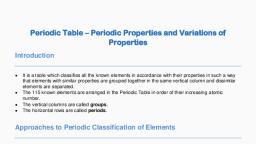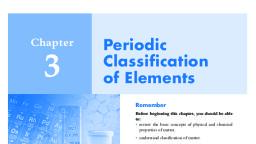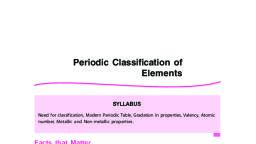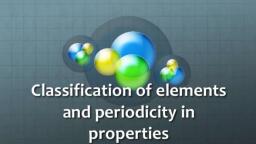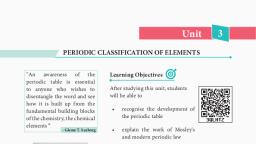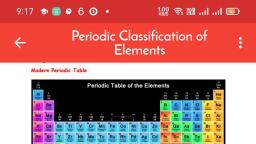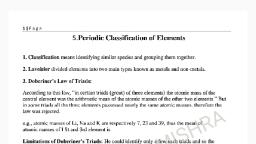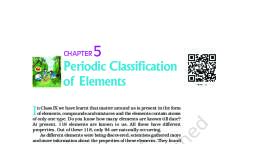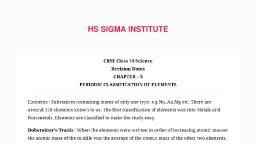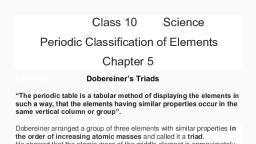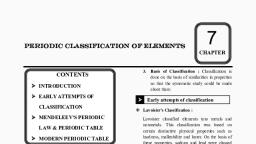Page 1 :
Periodic Table – Periodic Properties and Variations of, Properties, Introduction, , , , , , It is a table which classifies all the known elements in accordance with their properties in such a way, that elements with similar properties are grouped together in the same vertical column and dissimilar, elements are separated., The 115 known elements are arranged in the Periodic Table in order of their increasing atomic, number., The vertical columns are called groups., The horizontal rows are called periods., , Approaches to Periodic Classification of Elements, , Dobereiner’s Triads, In 1817, Dobereiner classified elements with similar chemical properties into groups of three called triads., He noted that the atomic mass of the middle element in a triad is the arithmetic mean of the other two., This is called Dobereiner’s Law of Triads., 7, , Li, , 23, , Na, , At. mass of sodium =, 40, , Ca, , 87, , Cl, , K, , 7 + 39, = 23, 2, 137, , Sr, , At. mass of strontium =, 35·5, , 39, , Ba, , 137 + 40, = 88·5, 2, 79, , Br, , 127, , I, , 35·5 + 127, At. mass of bromine =, = 81·25, 2, , Newlands’ Law of Octaves, In 1864, Newlands arranged elements in the increasing order of atomic mass and noticed that the eighth, element was similar in physical and chemical properties to the first element, just like the eight nodes in, music. This relationship is called the Law of Octaves., , Lother Meyer’s Law, In 1869, Lother Meyer classified that atomic volume is the periodic function of atomic mass.
Page 2 :
Mendeleev’s Periodic Law, In 1869, Mendeleev stated the law of chemical periodicity., The physical and chemical properties of elements are a periodic function of their atomic masses; i.e. when, the elements are arranged in the increasing order of their atomic masses, the elements with similar, properties are repeated after certain regular intervals., This is called Mendeleev’s Periodic Law., Certain anomalies of Mendeleev’s table were, (i), Position of hydrogen, (ii), (iii), Position of isotopes, (iv), (v), Anomalous pairs of elements, (vi), , Position of rare earths, Position of Noble gases, Cause of periodicity, , Modern Periodic Law, The physical and chemical properties of elements are a periodic function of their atomic numbers., , Long Form of the Periodic Table, It is based upon the modern periodic law, i.e. elements are arranged according to the increasing order of, their atomic number., , Periods, The horizontal rows of elements in a periodic table are called periods. There are seven periods in the, long form of the periodic table., The first period consists of 2 elements called the shortest period., The second and third periods consist of 8 elements called short periods., The fourth and fifth periods contain 18 elements each and are called long periods., The sixth period consists of 32 elements and it is the longest period., The seventh period is yet an incomplete period., Groups, The modern periodic table has eighteen vertical columns known as groups, arranged from left to right, in the order: IA, IIA, IIIB, IVB, VB, VIB, VIIB, VIII (three columns), IB, IIB, IIIA, IVA, VA, VIA, VIIA and, Zero., A group is determined by the number of electrons present in the outermost shell., Elements in groups 1, 2 and 13 to 17 are called normal elements., Elements in groups 3 to 12 are called transition elements., Group 18 at the extreme right contains noble or inert gases., Reactive metals are placed in groups 1 and 2., Transition elements [metals] are placed in the middle., Non-metals are placed in the upper right corner of the periodic table.
Page 3 :
Periodicity, The properties which reappear at regular intervals, or in which there is gradual variation at regular, intervals, are called periodic properties, and the phenomenon is known as the periodicity of elements., , Shells/Orbits, Electrons in an atom revolve around the nucleus in certain selected but fixed concentric circular paths, called shells or orbits. These are associated with a definite amount of energy and are also called energy, levels., , Valency, , , , , , It denotes the combining capacity of the atom of an element. It is equal to the number of electrons an, atom can donate or accept or share., On moving from left to right in a period, the number of valence electrons increases from 1 to 8., Certain elements lose electrons in steps and hence show variable valency, e.g. Cu, Fe, Ag, Au etc., On moving down a group, the valence electrons and valency of all the elements in a group remain the, same., , Periodic Properties of Elements, , , , , , , , , , Atomic size (atomic radii), It is the distance between the centre of the nucleus of an atom and its outermost shell., Metallic Character, Those elements which have a tendency to lose their valence electrons and form a positive ion are, considered as metals., Na − e− → Na+, Non-metallic Character, Those elements which have a tendency to gain electrons in order to attain an octet in their outermost, orbit are considered as non-metals., Example: Cl + e−, Cl−, , , (2, 8, 7), (2, 8, 8), Chemical Reactivity, In metals, greater the tendency to lose electrons, greater is the reactivity., In non-metals, greater the tendency to gain electrons, greater is the reactivity., Ionisation Energy, The energy required to remove an electron from a neutral isolated gaseous atom and convert it into a, positively charged gaseous ion is called ionisation energy (IE) or first ionisation energy (IE1)., Electron Affinity (EA) or Electron Gain Enthalpy, The amount of energy released while converting a neutral gaseous isolated atom into a negatively, charged gaseous ion by the addition of electrons is called electron affinity.
Page 4 :
, , , , , Electronegativity, The tendency of an atom in a molecule to attract the shared pair of electrons towards itself is called its, electronegativity., Atomic Number (Z), The atomic number of an element is equal to the number of protons in the nucleus., The atomic number is a unique property of an element, because no two elements have the same, atomic number., Mass Number (A), The mass number of an element is the sum of the number of protons and neutrons in the nucleus of, the atom of the element., , Variation of Periodic Properties in the Periodic Table, , Periodic Properties, In Group, Atomic size, The atomic radii of elements, increase in a group on moving, from top to bottom., , In Period, The atomic radii of elements, decrease in a period from left, to right with an increase in, atomic number., , Ionisation energy, , The ionisation potential, The ionisation potential, decreases in a group on going increases in a period on going, from top to bottom., from left to right., , Electron affinity, , On going down a group,, electron affinity decreases., , Electronegativity, , The electron affinity increases, in going from left to right in a, period., Electronegativity of elements, Electronegativity of elements, gradually decreases from top to increases in going from left to, bottom., right across the period., , Metallic character, , The metallic character of, elements increases down a, group., , The metallic character of, elements gradually decreases, on moving from left to right., , Non-metallic, character, Basic nature of, oxides, , The non-metallic character, decreases down the group., The basic nature of the oxides, of the metals increases down a, group., The chemical reactivity of the, metal increases and of nonmetal decreases on going, down the group., , The non-metallic character, increases across a period., The basic nature of the oxides, decreases across the period, and finally becomes acidic., The chemical reactivity of, elements first decreases and, then increases from left to right, in a period., , Chemical reactivity
